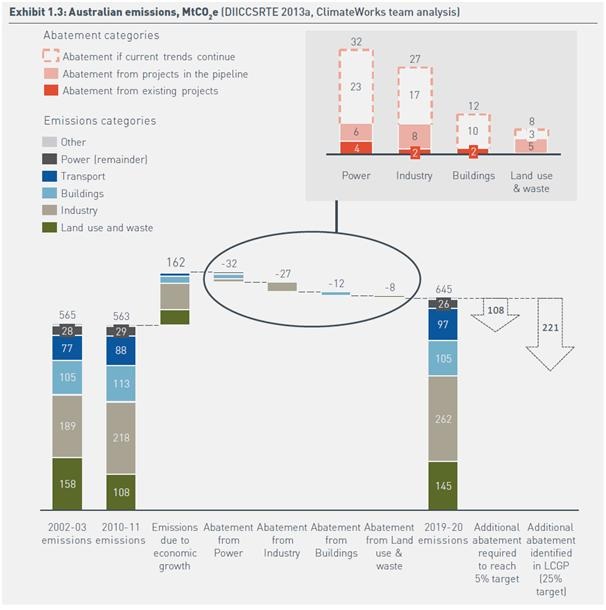Australia's emissions good news
ClimateWorks has released a new report tracking Australia’s progress in reducing emissions.
The report seeks to emphasise the good news which can often be ignored, showing that we are making gains in a number of areas. It finds that over the past decade, there has been no growth in greenhouse gas emissions while the economy has grown 31 per cent.
Looking forward, ClimateWorks expects changes already underway (such as the Renewable Energy Target) could deliver 80 million tonnes of abatement by 2020 and would take us 40 per cent of the way towards the 5 per cent emission reduction target.
This is illustrated in the charts below, which show emissions in 2010-11 were 563M tonnes versus 565 in 2002-03. Without action these emissions are projected to grow by 162M tonnes CO2-e. However a series of initiatives already in train are expected to contain this growth to 82M tonnes.

Source: ClimateWorks Australia (2013)
The chart in the top right provides a break down on where ClimateWorks expect the future reductions to come from.
Within the power sector most of the improvement is down to the government’s Renewable Energy Target. Unfortunately this is something which could evaporate if the target is downgraded by a review the Coalition intends to undertake next year.
Within industry there has been a noticeable pick-up in energy efficiency improvement since 2008. ClimateWorks say this has been driven primarily by the rising price of electricity. In addition it has been assisted by the Energy Efficiency Opportunities Program and increased management attention on energy because of carbon pricing. The report suggests improvements to energy efficiency will deliver 15.4M tonnes of abatement to 2020. Further gains are expected from:
-- Reductions in fugitive methane emissions from oil, gas and coal extraction (6Mt); and
-- Reductions in cement clinker CO2 as well as N2O emissions from production of fertiliser and explosives (5.7Mt).
Within buildings, emissions grew by 8 per cent between 2002-03 and 2010-11 even though commercial floor space increased by 17 per cent, and the number of households grew by 12 per cent. Looking forward to 2020 ClimateWorks expects further improvements in energy efficiency can reduce emissions relative to BAU in commercial buildings by 2.2Mt and residential by 4Mt. It also expects growth of distributed energy, in particular solar PV, will contribute an additional 6.3 Mt of abatement.
Land use and waste management were the big reason behind Australia managing to contain its emissions over the past decade. Deforestation emissions dropped from 55Mt in 2002-03 to 11Mt in 2010-11, driven largely by Queensland laws which have recently been watered down. However it is not expected to play such a big role in the future, contributing just 8Mt of abatement to 2020. The other issue being whether relaxation of these Queensland laws will mean it actually contributes little abatement at all.
So what’s the end conclusion from all of this?
It’s damn hard to tell. That’s because many of the emission trends that look so rosy are dependent on government policy being maintained.
Some changes are independent of climate change policy. For example industry energy efficiency is primarily being driven by increases in electricity and gas prices that have little to do with climate policy. But a large proportion could be easily reversed with the stroke of a legislative pen.













